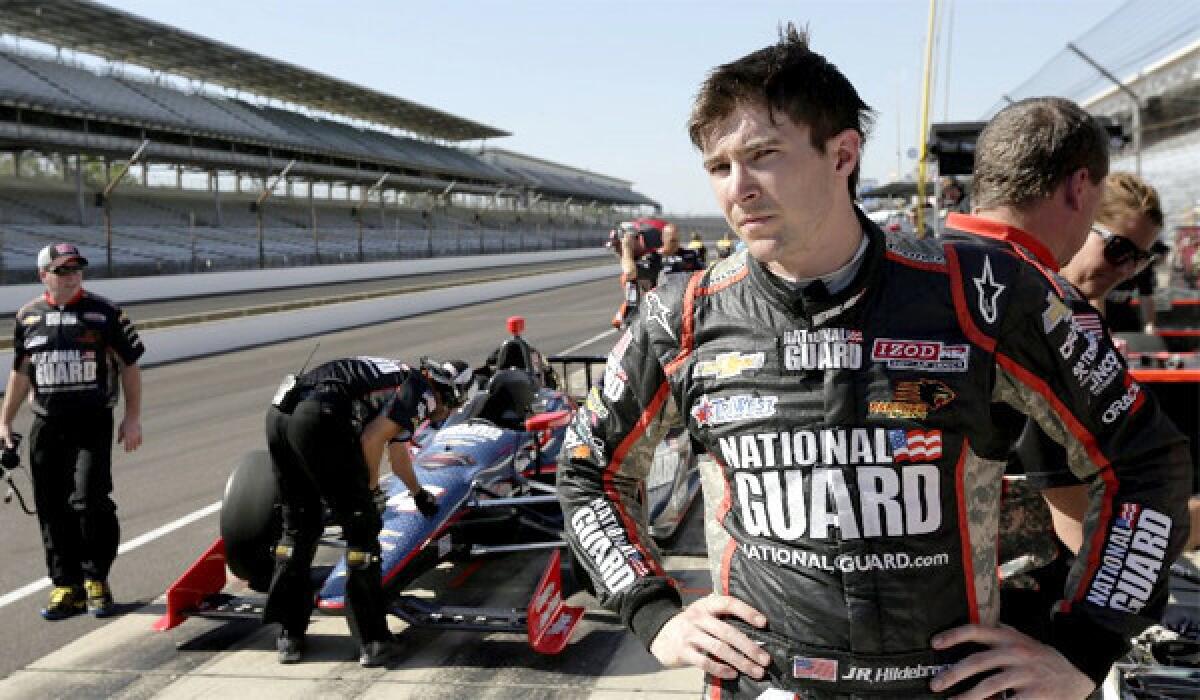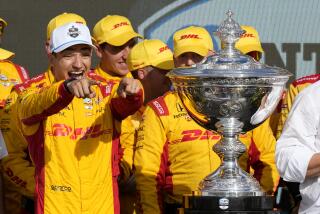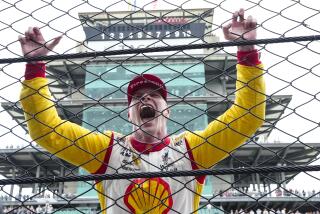JR Hildebrand seeks a new Indianapolis 500 story to tell

It was two years ago that IndyCar driver JR Hildebrand made a career-defining move at the Brickyard. But it’s not the one you think.
Hildebrand, a rookie from Sausalito, Calif., entered the last turn of the last lap of the Indianapolis 500. Astonishingly, he was the leader. More astonishing were the events that followed.
He came up too fast on a slowing Charlie Kimball, then tried to go around on the high side, where loose debris settles after hours of being blown there by cars going 200 mph.
Hildebrand didn’t make it. He hit the wall, Dan Wheldon passed him to win the race and Hildebrand, right side smashed, limped home in second place.
As Hildebrand crossed the little row of bricks that is the finish line, not knowing whether he was 2nd or 22nd, he chose to define his career. He decided to stand up. Figuratively.
“I knew, when that first microphone was stuck in my face,” he says, “that however I handled it could affect the rest of my career. I decided there would be no excuses, regardless of what I really thought had happened. I was gonna raise my hand.”
When he did exactly that, it left the media, used to finger-pointing and blame-placing in the aftermath of events, surprised and impressed.
For additional perspective, let’s let Hildebrand tell it like it was, that May day in 2011.
“We decided to gamble,” he says. “The numbers are a little fuzzy now, but we thought, if we pitted with around 35 laps left, we could make it to the end without more fuel. We were running fifth or sixth.
“If the yellow came out, we lost our gamble. If fuel estimates were wrong and we had to slow down, we had lost.”
“I had fuel numbers in the car — gallons used per lap. I was clicking them off, 10 laps to go, nine, eight. …
“Dario Franchitti took the same gamble, but with about four laps to go he slowed. That left Scott Dixon, who was running all out and would have easily won the race. But his crew had messed up his last pit stop. Suddenly, he wasn’t challenging.
“So, with one lap to go, I’m in the lead and very cognizant that the only threat was Dan.
“When I crossed the finish line for the last lap, I was a full corner ahead. He was not going to be a serious threat unless something weird happened, or we ran out of gas.
“I got through Turns 1 and 2, the toughest part. Near Turn 3, I could see two cars ahead, but assumed they were running all out. When I got to Turn 4, it took milliseconds to realize how slow Charlie was going. I had two choices, hit the brakes or pass on the right.”
Hildebrand says he made an instinctive choice, from years of competing in athletics.
“There was no way in hell I was going to finish second by pussyfooting,” he says. “You have a moment of helplessness when you know you are going to hit the wall. You have no control.”
But he took some. He stayed on the gas, keeping the car straight along the wall, rather than spinning to a stop. That allowed it to get to the finish line.
“I only had about 500 yards left,” he says.
As he skidded along, contributing lore to the event billed as “the Greatest Spectacle in Racing,” Hildebrand says he was already thinking of how he would face the music.
“What we do is competitive,” he says. “I expected massive backlash. I know how this works. People who watch expect you to be great all the time. If I were watching, I’d expect the same.
“I was also sponsored by the National Guard. I had a responsibility to that. I’m a nostalgic American, not a flag-waving one.”
He clicked back into driver’s mode when he realized he had no brakes. He banged harmlessly into the wall on Turn 1 and finally stopped. It was time to climb out and start facing the music.
Still a racing rookie, he performed like a public relations pro.
Sunday, he will start 10th in the Indy 500. He says he is happy with his car, that his focus all month has been more on racing than on qualifying.
Hildebrand the rookie had replaced Wheldon on the Panther Racing team in 2011, then lost the biggest race of his life to the man he had replaced.
He was still a rookie when, five months later at Las Vegas, he was near the front of a 15-car wreck that sent the popular Wheldon’s car airborne into a fatal crash and put Hildebrand in the hospital.
He is no longer a rookie. At 23, he had a defining moment in his sport. Now, at 25, he hopes to have another, but in his race car, rather than in front of reporters.
That would create a moment of irony. Hildebrand will drive a DW12 Chevrolet. The chassis is named in honor of Wheldon.
More to Read
Go beyond the scoreboard
Get the latest on L.A.'s teams in the daily Sports Report newsletter.
You may occasionally receive promotional content from the Los Angeles Times.











